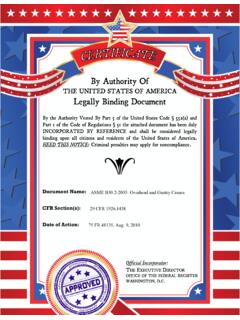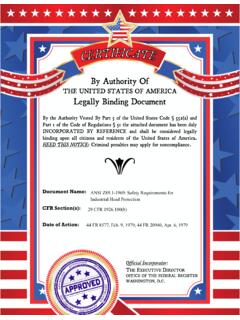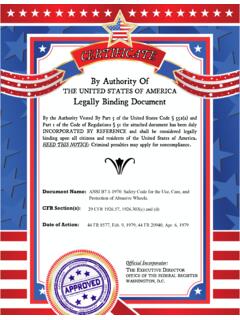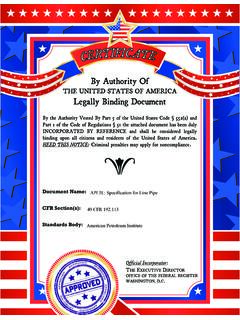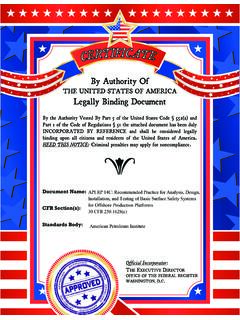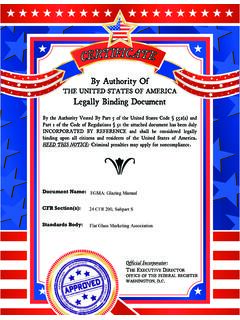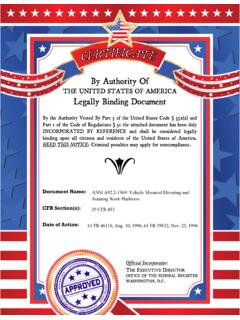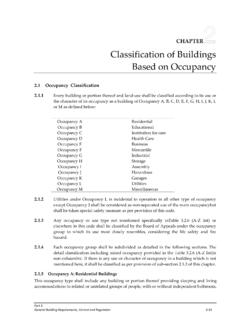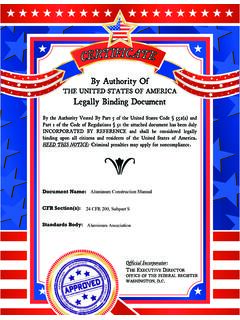Transcription of IS 13367-1 (1992): Safe use of cranes - Code of practice ...
1 Disclosure to Promote the Right To InformationWhereas the Parliament of India has set out to provide a practical regime of right to information for citizens to secure access to information under the control of public authorities, in order to promote transparency and accountability in the working of every public authority, and whereas the attached publication of the Bureau of Indian standards is of particular interest to the public, particularly disadvantaged communities and those engaged in the pursuit of education and knowledge, the attached public safety standard is made available to promote the timely dissemination of this information in an accurate manner to the public. ! $ ' + - Satyanarayan Gangaram Pitroda Invent a New India Using Knowledge 0 1 ' 5 Jawaharlal Nehru Step Out From the Old to the New 1 + , 1 + Mazdoor Kisan Shakti Sangathan The Right to Information, The Right to Live !
2 > 0 B Bhart hari N ti atakam Knowledge is such a treasure which cannot be stolen Invent a New India Using Knowledge IS 13367-1 (1992): Safe use of cranes - Code of practice ,Part 1: General [MED 14: cranes , Lifting Chains and RelatedEquipment], IS 13367 ( Part 1 ) : 1992 Indian Standard SAFE USE OF cranes - CODE OF practice * PART 1 GENERAL UDC 621 873 : 614 8 September 1992 0 BIS 1992 BUREAU OF INDIAN standards MANAK BHAVAN, 9 BAHADUR SHAH ZAFAR MARG NEW DELHI 110002 1 Price Group 11 --- x cranes , Lifting Chains and Associated Equipment Sectional Committee, HMD 14 1 2 3 4 5 6 7 8 9 10 11 12 13 14 15 16 17 18 19 20 CONTENTS SCOPE .. REFERENCES .. DEFINITIONS .. MANAGEMENT OF THE LIFTING OPERATION .. PLANNING OF THE LIFTING OPERATION .. SELECTION OF PERSONS .. RECOMMENDED MINMUM ATTRIBUTES .. DESCRIPTION AND SELECTION OF TYPES OF cranes SAFETY.
3 SITING OF cranes ._.. ERECTION AND DISMANTLING .. PROCEDURES AND PRKAUTIONS .. OPERATING CONDITIONS .. TESTING AND EXAMINATION .. LEGAL REQUIREMENTS .. ROPES .. SLINGING AND HANDLING OF LOADS ..* RAISING OR LOWERING OF PERSONS .. BALLING OPERATIONS .. SIGNALLING SYSTEMS .. * .. TABLES 1 SEVERITY OF DETERIORATION OF steel WIRE ROPES *.. 2 TYPICAL EXAMPLES OF CUMULATIVE EFFECT OF DETERIORATION OF steel WIRE ROPES 3 WEIGHT OF MATERIALS .. FIGURES 1 EFFECT OF A SWINGING LOAD ON LOAD RADIUS .. 2 RECOMMENDED CRANE SIGNALS .. 3 TRAVELLING UNDER OVERHEAD ELECTRIC LINES AND CABLES .. 4 SIDE LOADING ON JIB .. 5 CORRECT METHOD OF PAYING OUT ROPE .. 6 SERVING OF ROPES ( BEFORE CUTTING ) .. 7 TRANSFERRING ROPE FROM REEL TO DRUM .. 8 PARTS OF THE CRANE TO BE CONSIDERED DURING THE EXAMINATION .. FOREWORD PAGE I 1 1 1 3 3 4 7 8 10 12 13 15 20 22 22 31 32 32 33 30 30 31 2 5 II 16 23 24 25 28 This Indian Standard was adopted by the Bureau of Indian standards , after the draft finalized by the cranes , Lifting Chains and Associated Equipment Sectional Committee had been approved by the Heavy Mechanical Engineering Division Council.
4 It is in the interest of all those involved in lifting operations to ensure that lifting operation are carried out efficiently and safely. objectives. It is the aim of this code to assist crane users to achieve these It is felt that management and organization of such operations are the foundation stones 0; which the successful operations may be built. regardless of the type of crane being used. These foundation stones are essential to all operations ( Continued on third cover ) Indian Standard IS 13367 (Part 1) : 192 SAFE USE OF cranes - CODE OF practice PAR? 1 GENERAL 1 SCOPE X,1 This standard gives guidance for the safe use of all types of cranes . Subjects covered include safe system of work, management, planning, general recommendations for selection, installation, testing, operation and maintetince of aan& and for the selection of drivers, slingers and signallers. Reference is also made to relevant legislation and attention is drawn to statutory requirements for the testing and examination of cranes .
5 2 KEFERENCES The following Indian standards are necessary adjuncts to this Standard: IS No.. Title 808 : 1989 8324 : l 76 dimensions for hot- rolled steel beam , column, channel and angle sections ( third revision ) Code of practice for safe use and maintenance of non-calibrated round steel link lifting chains and chain slings experience of the crane and the equipment used in the lifting operation as is necessary-to- carry out the function to which the term relates in each particular context. Driver ,! ! i , The person who is operating the crane for the purpose of positioning loads. Driver does not include any person who is operating a crane for erection of the crane itself. Lesld Radius Indicator f A deviee fitted on a crane that shows the radius of the hook and the corresponding safe working load. I Radius The horizontal distance between the point at which the centre of rotation of the crane meets the ground, and the vertical centreline through the hook (see Fig.)
6 1). Safe Working Load The maximum load that can be safely handled by a crane at a specified position and under specified conditions. 3 DEFINITIONS Service Conditions For the purposes of this code, the following definitions shall apply. qppointed Person The person appoiated by @e management or organization requiring the lifting operation to be undertaken who will be responsible for all aspects of the lifting operation. Automatic Safe Load Indicator A device fitted to a crane, or incorporated in its design, that automatically gives5 visual indication to the driver when the load being lifted pr carried by the crane approaches the safe working load, and that also gives a continuous audible warning to the driver and other persons in the vicinity when the load being lifted or carried exceeds the safe working load (see also ). Under certain statutory regulations the automatic safe load indicator should be of a type approved ,by the Chief Inspector of Factories (see also ).
7 3.; Cliompetent yet-son A person who is deemed to be competent and has. such practical and theoretical knowledge and such ai b) In-Service - With the crane handling loads up to the safe working loads in permissible wind pressures specified in the appropriate Indian Standard. Out-of-Service - With the crane either not required for use, or out of use when wind pressures exceed those permitted for in- service conditions, and without load on the hook. 4 MANAGEMENT OF THE LIFI ING OPERATION Safe System of Work A safe system of work (see ) should be established and followed for every lifting operation. T%is should include the planning of the operation, the provision, selection, maintenance and examination of the correct equipment and the provision of properly trained, competent personnel with adequate supervi,sion. The lifting operation should be taken to i&de any necessary preparation of a site and erection and #dismantling of the crane or cranes .
8 1 Always lift loa& gently and motions smoothly to avoid load swinging. ( A swinging load will increase the overturning moment of the aanes.) Use steady lines where necessary and where tbe load presents a wind catching area. Always travel with the load near to ground * level so load swinging can bk countrolled.. FIG. 1. E OF A SWINGING LOAD ON LOAD RADIUS The same principles should be applied when a series of lifting oKrations are being carried out at one site or the crane is a permanent fixture, for example, in a factory or at a dock. Appointed Person The management of the organization requiring the lifting operation to be undertaken should appoint a person with appropriate training and experience who should be competent. This person should be known as the appointed person. The appointed peion need not be an employee of the organixation and will not normally undertake the duties of crane driver, slinger or s&taller.
9 B) c) d) Duties of the Appdmted Person The management of the organjzstion requiring the lifting operation to be undertaken should specify the -duties of the appointed person which should include: e) a) The assessment of the lifting operation to provide such planning, selection of crane(s) 2 lifting gear and equipment, instruction and supervision as is necessary for the task to be undertaken safely. This should include consultation with other responsible bodies, if necessary (see ), and ensuring that where different organizations are involved they collaborate as necessary. Ensuring that there is an effective procedure for reporting defects and incidents (see ) and that adequate maintenance of the equipment is carried out. Responsibility for the organization of the team involved in the lifting operation. The nomination of persons to undertake the duties required for the operation including those listed in S or ensuring that this responsibility is delegated to an appropriate person or organization.
10 Responsibility for control 0; the lifting operation. This duty may be delegated to another person where considered appropriate IS 13367 (Part 1) : 1992 by the appointed person. It is undesirable that this duty should be undertaken by the crane driver because of the need for the crane driver to be at the crane controls throughout the operation. The appointed person should be given the necessary authority for the performance of all these duties and in particular, authority to stop the operation whenever he considers that danger is likely to arise should the operation continue. 5 PLANNING OF THE LIFTING OPERATION General Every lifting operation including crane erection and dismantling should be planned to ensure that it is - carried out in a safe manner. The extent of detailed planning will depend on the complexity of the overall operation but no operation should be considered so simple that the planning can be ignored.
